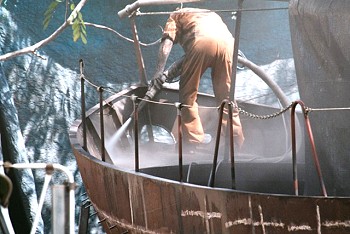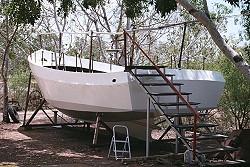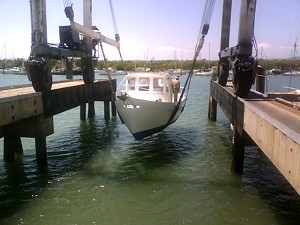Glen-L Boatbuilder of the Month (cont'd)
David Ainge - Union Jack
I have often read that building in steel is fast. That was
not my experience. Steel did seem quick in the early stages.
It didn't take too many weeks to make the frames, erect
them, put in the stiffeners, and tack on the hull plates.
Before long I was walking around in something that bore a
strong resemblance to a boat. The progress seemed great.  Then the
serious welding started, and went on, and on... One of the
hardest jobs was shaping the carling. I couldn't roll it,
so I shaped it with an oxy which took a long time.
Nevertheless, eventually the hull was finished, and again
living on acreage was helpful because I was able to have it
blasted on site, rather than transport it to a yard and back,
which was a big saving.
Then the
serious welding started, and went on, and on... One of the
hardest jobs was shaping the carling. I couldn't roll it,
so I shaped it with an oxy which took a long time.
Nevertheless, eventually the hull was finished, and again
living on acreage was helpful because I was able to have it
blasted on site, rather than transport it to a yard and back,
which was a big saving.
Building the ply superstructure was straightforward. I
covered it with dynel-epoxy, being familiar with that system
from my previous boat. Fitting out took about eighteen months
full-time. I have to say that it was more enjoyable than the
hull. I am basically a woodworker at heart, and on some of
our hot, humid days the protective clothing for steelwork was
very uncomfortable. I kept the general interior layout of
Union Jack but made some modifications to suit our
requirements. One example was that I did not make the settee
berth-back into a second bunk which could be lifted up for
use, because we do not anticipate any use for it. I also
altered the wheelhouse sole so that at some future time the
engine could be lifted up, and out through the door (not too
often, I hope). I enlarged the cockpit a little (with
corresponding additional drainage) and fitted a small table,
because this climate demands a good deal of sitting outside,
daytime and evening. I was uneasy about making the toilet
holding tank a part of the hull, worrying about future
corrosion in a hard-to-reach and nasty place, so I fitted a
flexible tank instead. I could not see the point of having
the rudder shaft emerge into the boat below the waterline,
with the potential for leaks/drips so I raised the shaft
tube, still using a stuffing box, of course.
I found the plans clear and accurate. They do require
careful study at some stages, but the necessary information
seems to be all there. Some additional measurements for
setting up the stem would have made that job easier. I
didn't get back to Glen-L with many questions, but when I
did, the responses were quick and helpful.
 You will
notice in the photos that I had a proper set of steps to the
boat. In view of the hundreds of times I went up and down
them, sometimes carrying large items, they were worth their
weight in gold. A ladder would make the job much harder, with
greater risk of a fall.
You will
notice in the photos that I had a proper set of steps to the
boat. In view of the hundreds of times I went up and down
them, sometimes carrying large items, they were worth their
weight in gold. A ladder would make the job much harder, with
greater risk of a fall.
We launched "Tabitha Too" ( our first boat was
"Tabitha") nearly two weeks ago. It was a very
nervous time, and it was hard to avoid some irrational
worries. Building a boat is, after all, a very big investment
in time and money, and we have all heard horror stories about
amateur boats being launched. In spite of all that, the
launch was uneventful. Tabitha Too sat about 1 inch above the
designed waterline, and slightly high at the stern, but a
full load of water should fix that. Our plan is to cruise the
waters of the Great Barrier Reef for a year, so we moved on
board on launch day. For the first twenty four hours I
couldn't stop looking into the bilge for leaks, but that
compulsion gradually subsided when I didn't find any.
Speaking of water in the bilges, I had Tabitha Too surveyed
during building, and the surveyor emphasised the importance
of keeping seawater out of a steel boat.  I have heard that they rust from
the inside. He recommended one of the expensive prop shaft
seals rather than a stuffing box, which needs a regular drip
to lubricate it. Unfortunately, finances didn't stretch
that far, so I used a traditional stuffing box, but
underneath I fitted a drip box made from left-over perspex.
It is quite big, so emptying it won't be a chore, and it
keeps the bilge dry.
I have heard that they rust from
the inside. He recommended one of the expensive prop shaft
seals rather than a stuffing box, which needs a regular drip
to lubricate it. Unfortunately, finances didn't stretch
that far, so I used a traditional stuffing box, but
underneath I fitted a drip box made from left-over perspex.
It is quite big, so emptying it won't be a chore, and it
keeps the bilge dry.
Our first boat was under-anchored, and we used to drag from
time to time. We had a moderate size CQR with chain and rope,
but even with a yacht which presented a fairly streamlined
profile to the wind, it wasn't up to the job. I was
determined not to be in that situation again, especially as
Union Jack presents a considerable area to the wind. This
time around I fitted the biggest CQR I could buy, and 1/2
inch chain. The breaking strain of that size chain is over
the top, but its weight helps to ensure that in moderate
winds at least, the pull on the anchor is horizontal, not
upwards. Time will tell, especially if we have to shelter
from a cyclone which is always a possibility in the tropical
summer.
We have had one short trip so far. To get from the launch
site to the marina we had to go out to sea for a few miles.
It was blowing 20-25 knots, with a short, choppy sea. Tabitha
Too handled it very well. We had to motor parallel to the
swell for a while, and Tabitha Too rolled a bit, but she
handled the conditions well and we quickly developed
confidence in her. I think she will prove to be a very
seaworthy vessel. We are looking forward to some very happy
times on her.
A final word. Before I built my first boat, others who had
been through the experience tried to tell me how long such a
project would take. I didn't believe them. Looking at a
31 foot boat it doesn't seem possible that it would take
3000-4000 hours to build. Professionals, of course, don't
take anywhere near that long, or they'd go broke. For the
amateur, however, that is the reality if you are doing all
the work yourself. If you want a boat of a similar size to
Union Jack, and you can't find that number of hours, buy
one, or build a house instead. I have built two boats and one
house, and the house was much quicker and easier.
I am very happy to discuss my experiences with anyone else
who is building.
Editor's Note: See all of David's Union Jack photos in Customer Photos.